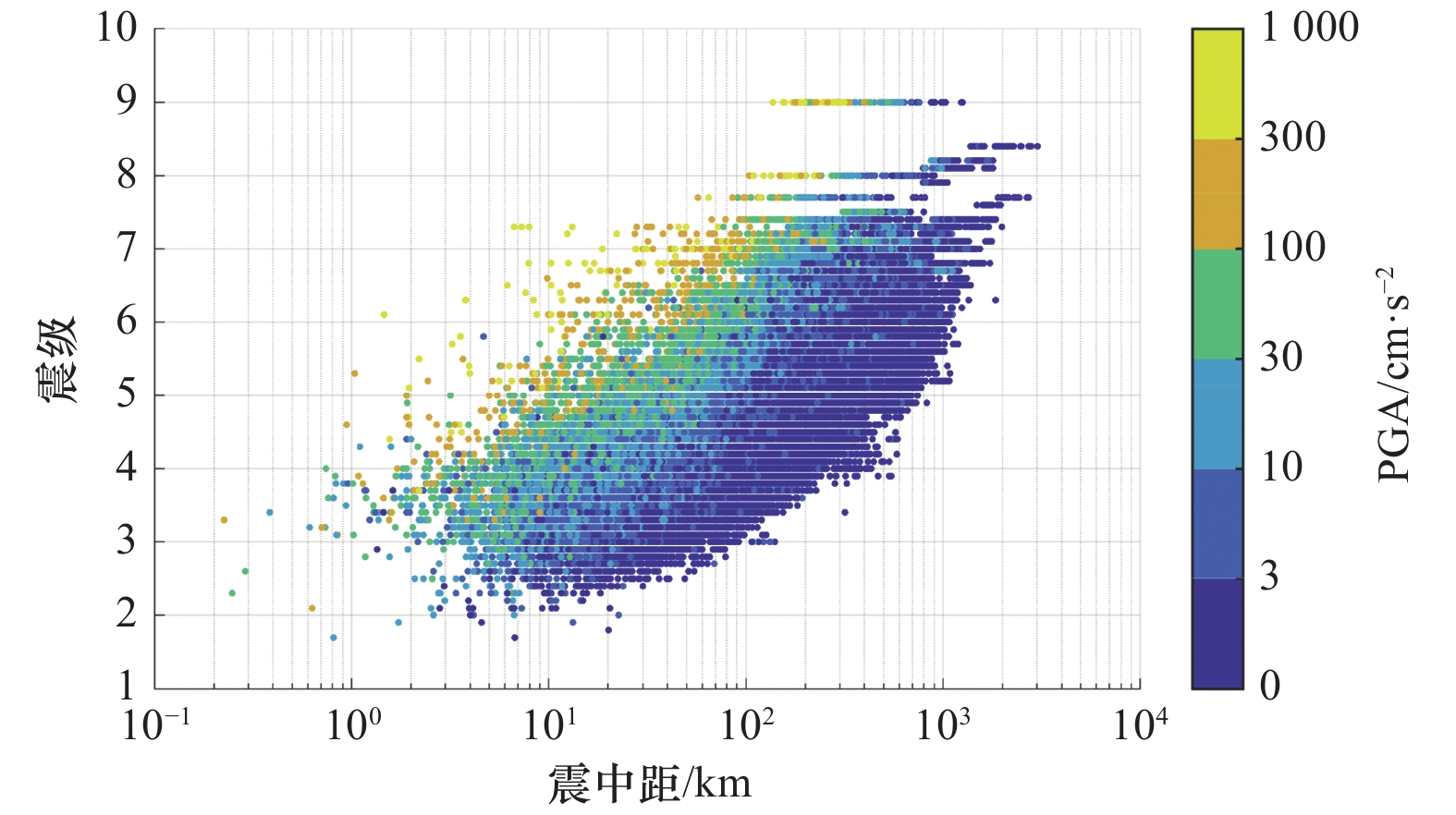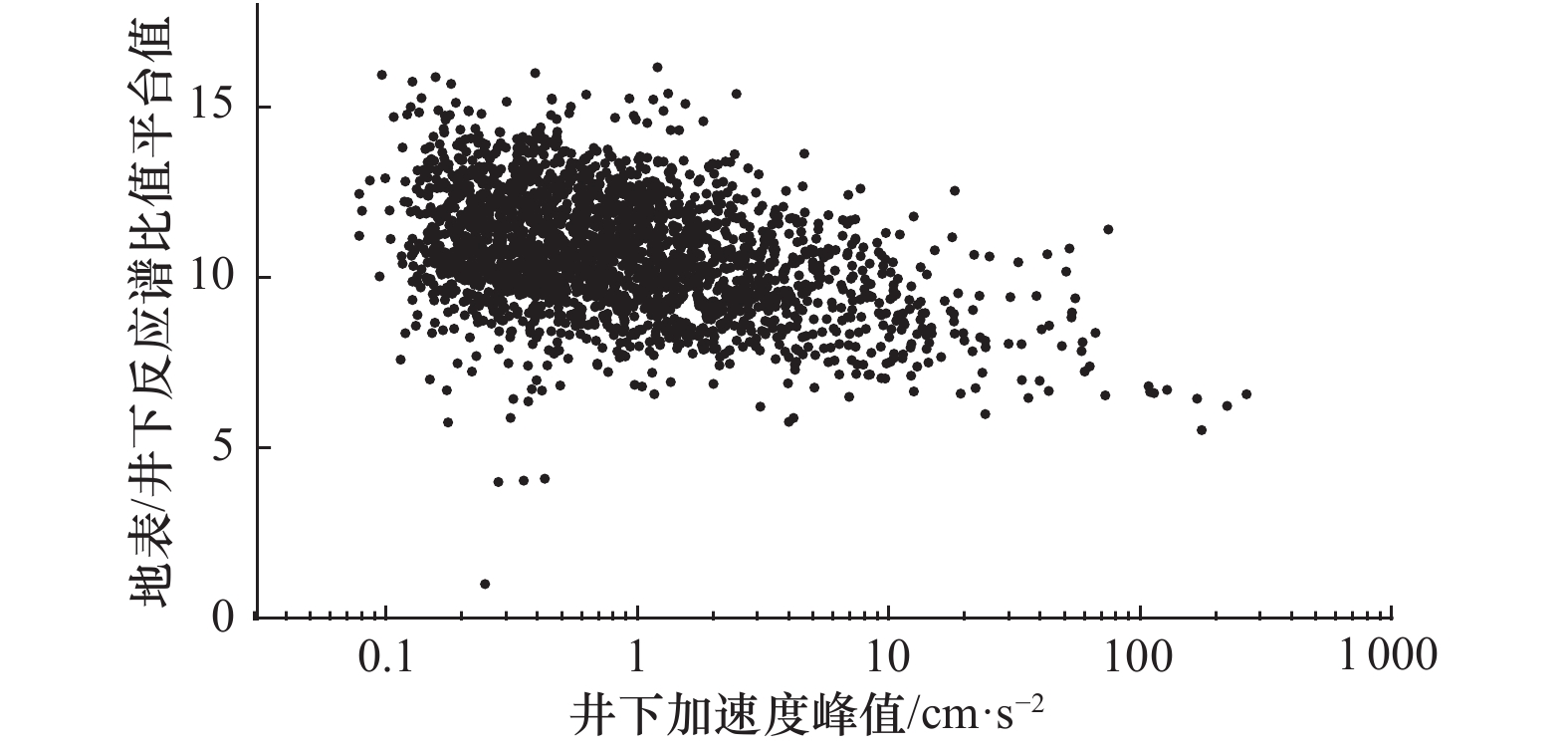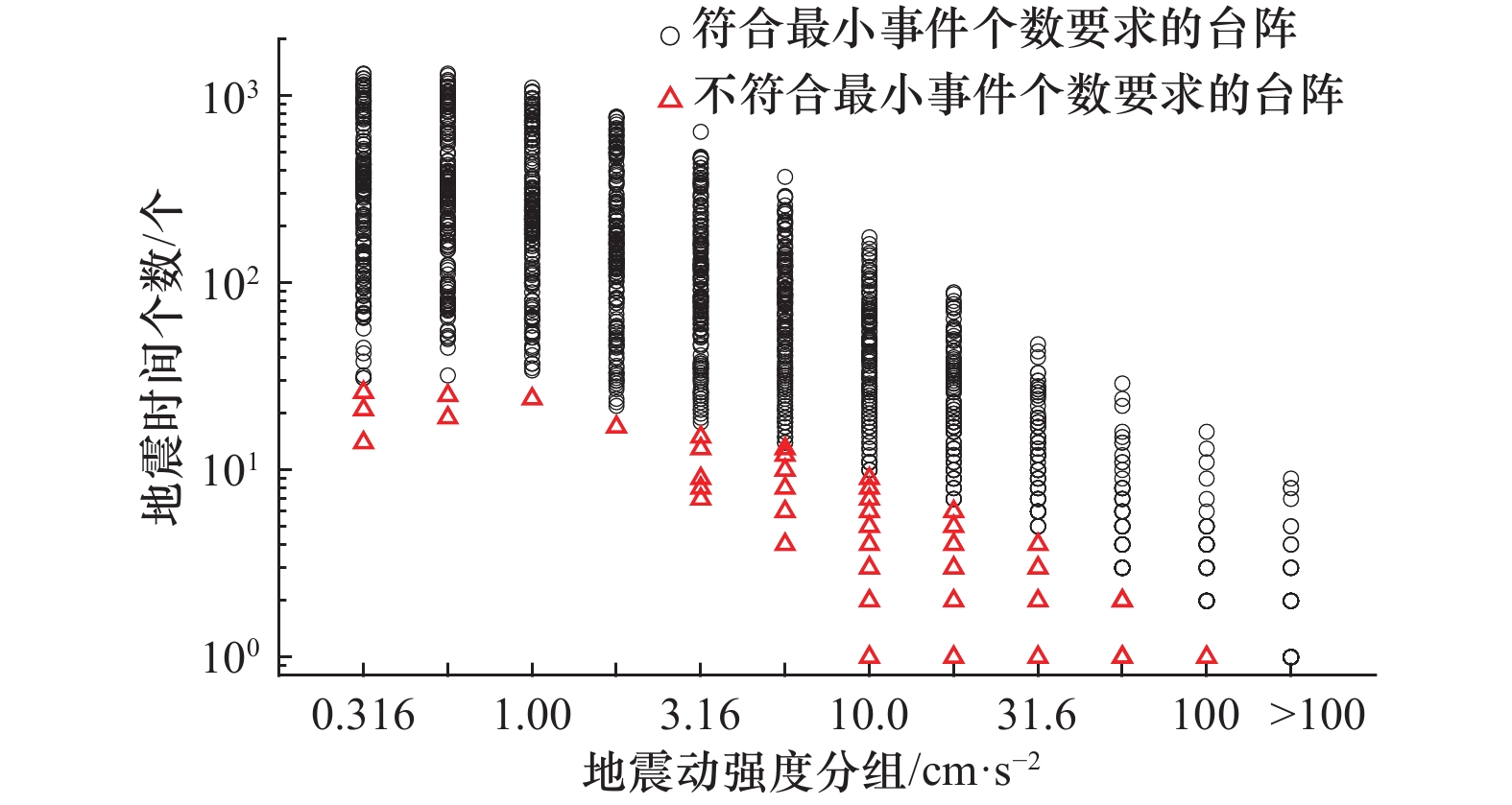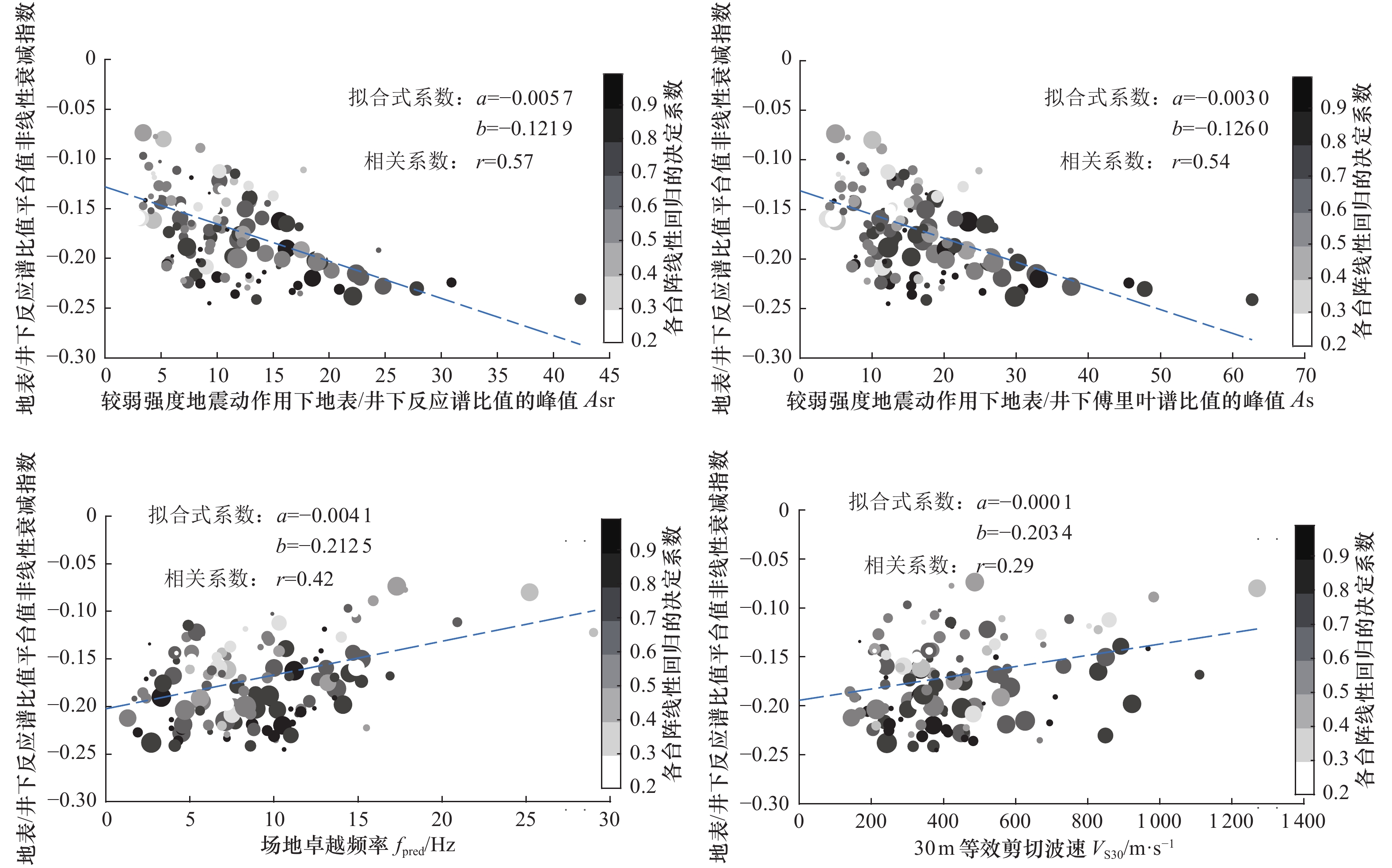Study on Nonlinear Statistical Characteristics of Surface/Downhole Response Spectrum Ratio and Influencing Factors
-
摘要: 浅地表软弱覆盖层对地震动的影响具有强非线性,但因观测记录样本量过小,难以通过参考谱比法等直接方法予以可靠分析。本文基于日本KiK-net台网136个竖向钻井台阵获取的141881组加速度记录的统计分析,研究了地表/井下反应谱比值随地震动强度变化的非线性变化规律与主要影响因素。利用变窗口尺度的滑动窗口平均法加强数据线性度,并确定了与地震动强度相关的台站最小记录样本量,统计结果表明地表/井下反应谱比值平台值随地震动强度变化的非线性衰减指数为−0.24~−0.08。利用套索(Lasso)算法统计回归发现,本研究12个场地特性表征参数中,30 m平均剪切波速(
$ {V}_{\mathrm{s}30} $ )、场地卓越频率与地表/井下反应谱比值非线性衰减指数具有较好的正相关性;较弱强度地震动作用下地表/井下傅里叶谱比值峰值、地表/井下反应谱比值峰值与地表/井下反应谱比值非线性衰减指数具有较好的负相关性。Abstract: The influence of shallow soft overburden on ground motion is strongly nonlinear, but it is difficult to make reliable analysis by direct methods such as reference spectral ratio method because of the small sample size of observation records. In this study, based on the statistical analysis of 141881 sets of acceleration records obtained from 136 vertical borehole array in Japan’s KiK-net network, the nonlinear variation of surface/downhole response spectrum ratio and its main influencing factors of field motion intensity were studied. The sliding window average method with variable window scale was used to enhance the linearity of the data, and the minimum sample size related to the ground motion intensity was determined. The statistical results show that the nonlinear attenuation index of ground motion intensity variation is between −0.24 and −0.08 for the platform value of the surface/underground response spectrum ratio. According to Lasso regression statistics, the average shear wave velocity of 30 m ($ {V}_{S30} $ ) and site predominant frequency have a good positive correlation with the nonlinear attenuation index of surface/downhole response spectrum ratio among the 12 site characteristic parameters studied. However, the peak values of the surface/downhole fourier spectrum ratio and the surface/downhole response spectrum ratio are negatively correlated with the nonlinear attenuation index of the surface/downhole response spectrum ratio under the weak ground motion.-
Key words:
- Strong motion /
- Site effect /
- Response spectrum /
- Nonlinear /
- Vertical borehole arrays
-
表 1 不同地震动强度分组下的最小可信样本量
Table 1. Minimum reliable sample size for different ground motion intensity groups
组别 1 2 3 4 5 6 7 8 9 10 11 12 分组标准/cm·s−2 0.178~
0.5620.316~
1.0000.562~
1.7801.000~
3.1601.780~
5.6203.160~
10.0005.620~
17.80010.000~
31.60017.800~
56.20031.600~
100.00056.200~
177.800>100.000 n0平均值/个 30 27 25 21 17 14 10 7 5 3 2 1 表 2 场地条件表征参数
Table 2. The site characterization parameters selected in this paper
参数 含义 定义 参考文献 $ {V}_{\rm{se}} $ 我国规范定义的等效剪切波速 ${V}_{\rm{se}}={d}_{0}/{\displaystyle\sum }_{i=1}^{n}\left({d}_{i}/{V}_{\mathrm{s}i}\right)$ 中华人民共和国住房和城乡建设部等,2010 $ {V}_{\mathrm{S}30} $ 美国规范定义的平均剪切波速 ${V}_{\mathrm{S}30}=30/{\displaystyle\sum }_{i=1}^{n}\left({d}_{i}/{V}_{\mathrm{s}i}\right)$ BSSC,2001(美国NEHRP规范) $ {B}_{30} $ 剪切波速剖面梯度 $ {\mathrm{log}}_{10}{V}_{\mathrm{s}}\left(z\right)={B}_{Z\mathrm{m}\mathrm{a}\mathrm{x}}{\mathrm{log}}_{10}\left(z\right)+{A}_{Z\mathrm{m}\mathrm{a}\mathrm{x}}\pm {\sigma }_{Z\mathrm{m}\mathrm{a}\mathrm{x}} $ Régnier等,2013 $ {Z}_{0.5} $ 0.5 km/s覆盖层厚度 剪切波速达0.5 km/s时的土层深度 中华人民共和国住房和城乡建设部等,2010 $ {Z}_{0.8} $ 0.8 km/s覆盖层厚度 剪切波速达0.8 km/s时的土层深度 Zhu等,2020 $ {Z}_{1.0} $ 1.0 km/s覆盖层厚度 剪切波速达1.0 km/s时的土层深度 Zhu等,2020 $ {V}_{\mathrm{s}\mathrm{a}\mathrm{v}} $ 整个土层沉积平均剪切波速 地表到$ {V}_{\mathrm{s}}>800 $ m/s的“地震基岩”
土层厚度内的走时平均剪切波速Pitilakis等,2013 $ {f}_{\mathrm{p}\mathrm{r}\mathrm{e}\mathrm{d}} $ 场地卓越频率 弱震平均傅里叶谱放大系数峰值对应的频率 Régnier等,2013 $ {f}_{\mathrm{s}} $ 场地基本频率 弱震HVSR曲线峰值对应的频率 陈国兴等,2020 $ {T}_{\mathrm{s}} $ 场地基本周期 $ {f}_{\mathrm{s}} $的倒数 陈国兴等,2020 $ {A}_{\mathrm{s}} $ 弱震平均傅里叶谱放大系数峰值 — Régnier等,2013 $ {A}_{\mathrm{s}\mathrm{r}} $ 弱震平均反应谱放大系数峰值 — -
[1] 陈国兴, 谢君斐, 张克绪, 1995. 土的动模量和阻尼比的经验估计. 地震工程与工程振动, 15(1): 73-84.Chen G. X., Xie J. F., Zhang K. X., 1995. The empirical evaluation of soil moduli and damping ratio for dynamic analysis. Earthquake Engineering and Engineering Vibration, 15(1): 73-84. (in Chinese) [2] 陈国兴, 丁杰发, 方怡等, 2020. 场地类别分类方案研究. 岩土力学, 41(11): 3509-3522, 3582.Chen G. X., Ding J. F., Fang Y., et al., 2020. Investigation of seismic site classification scheme. Rock and Soil Mechanics, 41(11): 3509-3522, 3582. (in Chinese) [3] 杜修力, 路德春, 2011. 土动力学与岩土地震工程研究进展. 岩土力学, 32(S2): 10-20.Du X. L., Lu D. C., 2011. Advances in soil dynamics and geotechnical earthquake engineering. Rock and Soil Mechanics, 32(S2): 10-20. (in Chinese) [4] 刘红帅, 2009. 基于小生境遗传算法的设计地震动反应谱标定方法. 岩土工程学报, 31(6): 975-979. doi: 10.3321/j.issn:1000-4548.2009.06.025Liu H. S., 2009. Calibrating method for seismic response spectra based on niche genetic algorithm. Chinese Journal of Geotechnical Engineering, 31(6): 975-979. (in Chinese) doi: 10.3321/j.issn:1000-4548.2009.06.025 [5] 罗桂纯, 2016. 基于强震动观测的场地效应非线性特性研究. 国际地震动态, (1): 46-48. [6] 王海云, 谢礼立, 2010. 自贡市西山公园地形对地震动的影响. 地球物理学报, 53(7): 1631-1638. doi: 10.3969/j.issn.0001-5733.2010.07.014Wang H. Y., Xie L. L., 2010. Effects of topography on ground motion in the Xishan park, Zigong city. Chinese Journal of Geophysics, 53(7): 1631-1638. (in Chinese) doi: 10.3969/j.issn.0001-5733.2010.07.014 [7] 王玉石, 李小军, 兰日清等, 2016. 强震动作用下土体非线性动力特征研究发展与展望. 震灾防御技术, 11(3): 480-492. doi: 10.11899/zzfy20160305Wang Y. S., Li X. J., Lan R. Q., et al., 2016. Development and prospect of study on soil nonlinear dynamic characteristics under strong-motion. Technology for Earthquake Disaster Prevention, 11(3): 480-492. (in Chinese) doi: 10.11899/zzfy20160305 [8] 夏江, 陈清军, 2006. 基于遗传算法的设计地震反应谱标定方法. 力学季刊, 27(2): 317-322. doi: 10.3969/j.issn.0254-0053.2006.02.021Xia J., Chen Q. J., 2006. Calibrating method of seismic response spectrum based on genetic algorithm. Chinese Quarterly of Mechanics, 27(2): 317-322. (in Chinese) doi: 10.3969/j.issn.0254-0053.2006.02.021 [9] 叶鹏, 2013. 四川地区强震动台站的场地反应研究. 哈尔滨: 中国地震局工程力学研究所.Ye P., 2013. Study on site responses of strong motion stations in Sichuan area. Harbin: Institute of Engineering Mechanics, China Earthquake Administration. (in Chinese) [10] 袁晓铭, 孙锐, 孙静等, 2000. 常规土类动剪切模量比和阻尼比试验研究. 地震工程与工程振动, 20(4): 133-139. doi: 10.3969/j.issn.1000-1301.2000.04.020Yuan X. M., Sun R., Sun J., et al., 2000. Laboratory experimental study on dynamic shear modulus ratio and damping ratio of soils. Earthquake Engineering and Engineering Vibration, 20(4): 133-139. (in Chinese) doi: 10.3969/j.issn.1000-1301.2000.04.020 [11] 张立宝, 2018. 基于钻井台阵数据的场地非线性效应研究. 北京: 中国地震局地球物理研究所.Zhang L. B., 2018. Study on nonlinearity of site effects on ground motion based on vertical borehole array data. Beijing: Institute of Geophysics, China Earthquake Administration. (in Chinese) [12] 中华人民共和国住房和城乡建设部, 中华人民共和国国家质量监督检验检疫总局, 2010. GB 50011—2010 建筑抗震设计规范(附条文说明)(2016年版). 北京: 中国建筑工业出版社.Ministry of Housing and Urban-Rural Development of the People’s Republic of China, General Administration of Quality Supervision, Inspection and Quarantine of the People’s Republic of China. 2010. GB 50011—2010 Code for seismic design of buildings. Beijing: China Architecture & Building Press. (in Chinese) [13] Aguirre J., Irikura K., 1997. Nonlinearity, liquefaction, and velocity variation of soft soil layers in Port Island, Kobe, during the Hyogo-ken Nanbu earthquake. Bulletin of the Seismological Society of America, 87(5): 1244-1258. [14] Aki K., 1993. Local site effects on weak and strong ground motion. Tectonophysics, 218(1-3): 93-111. doi: 10.1016/0040-1951(93)90262-I [15] Andrews D. J., 1986. Objective determination of source parameters and similarity of earthquakes of different size. In: Das S., Boatwright J., Scholz C. H., eds., Earthquake Source Mechanics. Washington: American Geophysical Union, 259—267. [16] Beresnev I. A., Field E. H., Van Den Abeele K., et al., 1998. Magnitude of nonlinear sediment response in Los Angeles basin during the 1994 Northridge, California, earthquake. Bulletin of the Seismological Society of America, 88(4): 1079-1084. [17] Bernardie S., Foerster E., Modaressi H., 2006. Non-linear site response simulations in Chang-Hwa region during the 1999 Chi–Chi earthquake, Taiwan. Soil Dynamics and Earthquake Engineering, 26(11): 1038-1048. doi: 10.1016/j.soildyn.2006.02.004 [18] Bonilla L. F., Steidl J. H., Gariel J. C., et al., 2002. Borehole response studies at the garner valley downhole array, Southern California. Bulletin of the Seismological Society of America, 92(8): 3165-3179. doi: 10.1785/0120010235 [19] Bonilla L. F., Tsuda K., Pulido N., et al., 2011. Nonlinear site response evidence of K-NET and KiK-net records from the 2011 off the Pacific coast of Tohoku Earthquake. Earth, Planets and Space, 63(7): 785-789. doi: 10.5047/eps.2011.06.012 [20] Borcherdt R. D., 1970. Effects of local geology on ground motion near San Francisco Bay. Bulletin of the Seismological Society of America, 60(1): 29-61. [21] Building Seismic Safety Council (BSSC), 2001. NEHRP recommended provisions for seismic regulations for new buildings and other structures, 2000 Edition. Washington, DC: Federal Emergency Management Agency. [22] Castro-Cruz D., Régnier J., Bertrand E., et al., 2020. A new parameter to empirically describe and predict the non-linear seismic response of sites derived from the analysis of Kik-Net database. Soil Dynamics and Earthquake Engineering, 128: 105833. doi: 10.1016/j.soildyn.2019.105833 [23] Darragh R. B., Shakal A. F., 1991. The site response of two rock and soil station pairs to strong and weak ground motion. Bulletin of the Seismological Society of America, 81(5): 1885-1899. [24] Field E. H., Johnson P. A., Beresnev I. A., et al., 1997. Nonlinear ground-motion amplification by sediments during the 1994 Northridge earthquake. Nature, 390(6660): 599-602. doi: 10.1038/37586 [25] Frankel A. D., Carver D. L., Williams R. A., 2002. Nonlinear and linear site response and basin effects in Seattle for the M 6.8 Nisqually, Washington, earthquake. Bulletin of the Seismological Society of America, 92(6): 2090-2109. doi: 10.1785/0120010254 [26] Hardin B. O., Drnevich V. P., 1972. Shear modulus and damping in soils: measurement and parameter effects. Journal of the Soil Mechanics and Foundations Division, 98(6): 603-624. doi: 10.1061/JSFEAQ.0001756 [27] Hartzell S., 1998. Variability in nonlinear sediment response during the 1994 Northridge, California, earthquake. Bulletin of the Seismological Society of America, 88(6): 1426-1437. [28] Héloïse C., Bard P. Y., Rodriguez-Marek A., 2012. Site effect assessment using KiK-net data: part 1. A simple correction procedure for surface/downhole spectral ratios. Bulletin of Earthquake Engineering, 10(2): 421-448. doi: 10.1007/s10518-011-9283-1 [29] Huang H. C., Shieh C. S., Chiu H. C., 2001. Linear and nonlinear behaviors of soft soil layers using Lotung downhole array in Taiwan. Terrestrial, Atmospheric and Oceanic Sciences, 12(3): 503-524. doi: 10.3319/TAO.2001.12.3.503(T) [30] Noguchi S., Sasatani T., 2008. Quantification of degree of nonlinear site response. In: The 14th World Conference on Earthquake Engineering. Beijing, China: WCEE. [31] Pavlenko O., Irikura K., 2002. Changes in shear moduli of liquefied and nonliquefied soils during the 1995 Kobe earthquake and its aftershocks at three vertical-array sites. Bulletin of the Seismological Society of America, 92(5): 1952-1969. doi: 10.1785/0120010143 [32] Pavlenko O. V., Wen K. L., 2008. Estimation of nonlinear soil behavior during the 1999 Chi-Chi, Taiwan, Earthquake. Pure and Applied Geophysics, 165(2): 373-407. doi: 10.1007/s00024-008-0309-9 [33] Pender M. J., 1997. Recent developments in earthquake geotechnical engineering. Bulletin of the New Zealand Society for Earthquake Engineering, 30(2): 167-173. doi: 10.5459/bnzsee.30.2.167-173 [34] Pitilakis K., Riga E., Anastasiadis A., 2013. New code site classification, amplification factors and normalized response spectra based on a worldwide ground-motion database. Bulletin of Earthquake Engineering, 11(4): 925-966. doi: 10.1007/s10518-013-9429-4 [35] Régnier J., Cadet H., Bonilla L. F., et al., 2013. Assessing nonlinear behavior of soils in seismic site response: statistical analysis on kik-net strong-motion data. Bulletin of the Seismological Society of America, 103(3): 1750-1770. doi: 10.1785/0120120240 [36] Régnier J., Cadet H., Bard P. Y., 2016. Empirical quantification of the impact of nonlinear soil behavior on site response. Bulletin of the Seismological Society of America, 106(4): 1710-1719. doi: 10.1785/0120150199 [37] Seed H. B., Idriss I. M., Kiefer F. W., 1969. Characteristics of rock motions during earthquakes. Journal of the Soil Mechanics and Foundations Division, 1969, 95(15): 1199-1218. [38] Steidl J. H., Tumarkin A. G., Archuleta R. J., 1996. What is a reference site?. Bulletin of the Seismological Society of America, 86(6): 1733-1748. [39] Tibshirani R., 2011. Regression shrinkage and selection via the lasso: a retrospective. Journal of the Royal Statistical Society: Series B (Statistical Methodology), 73(3): 273-282. doi: 10.1111/j.1467-9868.2011.00771.x [40] Trifunac M. D., Todorovska M. I., 1996. Nonlinear soil response-1994 Northridge, California, earthquake. Journal of Geotechnical Engineering, 122(9): 725-735. doi: 10.1061/(ASCE)0733-9410(1996)122:9(725) [41] Tsuda K., Archuleta R. J., Koketsu K., 2006. Quantifying the spatial distribution of site response by use of the Yokohama high-density strong-motion network. Bulletin of the Seismological Society of America, 96(3): 926-942. doi: 10.1785/0120040212 [42] Wen K. L., Beresnev I. A., Yeh Y. T., 1994. Nonlinear soil amplification inferred from downhole strong seismic motion data. Geophysical Research Letters, 21(24): 2625-2628. doi: 10.1029/94GL02407 [43] Wen K. L., Lin C. M., Chiang H. J., et al., 2008. Effect of surface geology on ground motions: the case of station TAP056-Chutzuhu site. Terrestrial, Atmospheric and Oceanic Sciences, 19(5): 451-462. doi: 10.3319/TAO.2008.19.5.451(T) [44] Zhu C. B., Pilz M., Cotton F., 2020. Which is a better proxy, site period or depth to bedrock, in modelling linear site response in addition to the average shear-wave velocity?. Bulletin of Earthquake Engineering, 18(3): 797-820. doi: 10.1007/s10518-019-00738-6 -





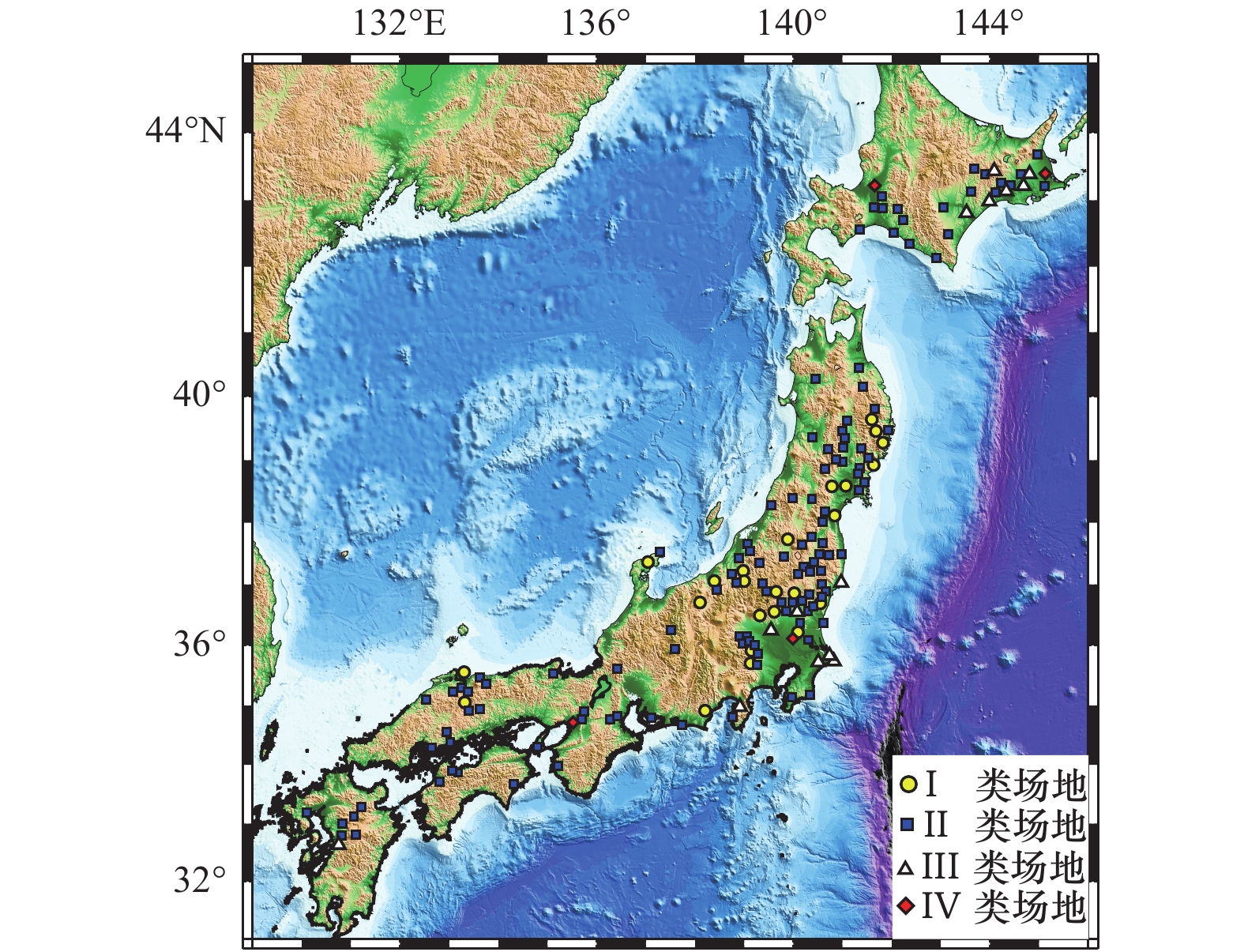
 下载:
下载:
